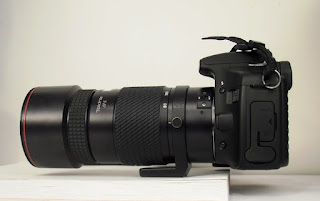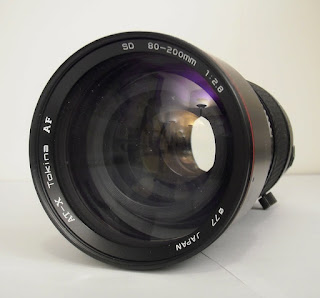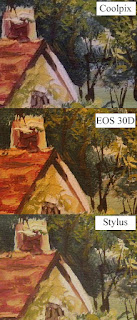Tech Specs
Focal Length: 80-200mm
Dimensions: 7.5” x 3.3”
Weight: 3ibs.
Maximum Aperture: f2.8
Minimum Aperture: f32
Diaphragm Blades: 9
Front Element: Rotates, extends about half an inch
Autofucus Mechanism: Micromotor (Canon version)
Closest Focus: 4.9 feet
Filter Size: 77mm
Background
Ever since as ascension of the zoom lens as a legitimate photographic tool in the late 1980s, constant f2.8 lenses in the 70/80-200 range have been extremely popular among both professionals and amateurs. Why? Simple: reach and speed make for a handy lens. As a result, everyone who makes lenses produces such optics, both manufacturer and third-party. To meet this need, Tokina started producing fast 80-200s almost as soon as AF became the norm. The lens reviewed here is the original AF 80-200, which commenced production in late 1980s.
Build Quality: 5
Tokina is a company known for its high standards of construction and the 80-200 f2.8 AT-X doesn't disappoint here, putting all lenses except the top of the line manufacturer versions to shame in a big way. Made out of solid metal, this lens is built like a tank and, weighing in at around 3 pounds, feels like one, too. With both its size and weight, this thing could legitimately be used as a weapon! Moving into the mechanics, it's a mixed bag. The zoom ring is absolutely buttery smooth without being loose and feels as though it's floating on air. One finger zooming with this lens is easy. As for the focus ring, well, it isn't a ring at all, but the inner barrel of the lens that is textured to look and feel like a ring. When it comes to focusing, the lens will extend about half an inch when focused at its closest distance. In terms of movement, the focus “ring” is a bit sloppy (at least on my lens). However, this being an old lens, this could also be from 20+ years of wear, too. Being in the first generation of Tokina AF lenses, this 80-200 doesn't incorporate the famous Tokina AF/MF clutch mechanism of the later version. However, as a whole, the positives of the solid metal construction and internal zoom trump the cheapish manual focusing mechanism.
The lens is built like, and weighs in like a tank too! Note the tripod collar: it rotates, but you can't take it off.
Autofocus Operation: 2
Being vintage 80s, the Tokina 80-200 f2.8 AT-X does not feature an ultrasonic drive, but a micromotor/mechanical drive, depending on your make. In terms of accuracy, the Tokina is good so long as the subject isn't moving fast and the lighting is reasonable. In fact, it's dead on in these situations 100% of the time for me on my Canon 30D. Unfortunately, the speed and tracking abilities of this lens leave a lot to be desired. To put it plainly, this is no sports/wildlife lens unless you'll be shooting golf and/or turtle races! In practice, I find that I only get about a 25% keeper rate with this lens when birding with it, not good. I'm just thankful that I'm shooting digital and not blowing wads of money with film and the cost of getting it developed! In terms of sound, the lens it pretty loud, but still nowhere near as loud as the slap of the SLR's mirror.
NOTE: the successor of this lens, the 80-200 f2.8 AT-X PRO (with the AF/MF clutch and internal focusing) is said to be a lot faster in terms of AF.
The focus ring isn't a ring and the lens extends a lot when focusing up close.
Optics: 3
Since there is so much to a zoom lens, it was only fair to test the Tokina 80-200 AT-X throughout the focal range. For this test, I used the focal length settings that are marked on the lensd, testing from wide-open f2.8 to f8.
Sharpness, a contest of tank vs. brick wall: which one wins?
Sharpness
Lens at 80mm
At its widest focal length setting, the Tokina 80-200 f2.8 AT-X performs quite well, especially considering its age. Wide open, the images are very sharp right from f2.8 . In terms of corner to corner sharpness, the entire field is good, with only minimal sharpness falloff in the corners, which in itself is eliminated by stopping down to f4.
Lens at 100mm
See the 80mm analysis, as the lens is identical in most regards except that the corners are sharper wide open at f2.8, no need to stop down here.
Lens at 140mm
Come the middle of the focal range, the lens starts to soften up a bit. Wide open, I personally wouldn't consider the result usable, thought it may be to people who don't have a problem applying a lot of sharpening in post-processing. No, it's not awful, but it sure isn't good, either. The good news is that, stopped down to f4, things improve a lot. Corner to corner sharpness is still consistent at all apertures.
Lens at 200mm
Fortunately, the lens has gotten over some of its issues by the end of the focal range. At 200mm, sharpness improves a bit, but it still isn't as good as it was at the 80/100mm settings. Corner to corner performance is still good here, too. In fact, I'd rate extreme corner performance at 200mm as better than it was at 140mm. Unfortunately, to get optimal sharpness, one has to stop down to f5.6 as f4 no longer gets the job done at the longest focal setting.
Pincushion distortion appears at 200mm
Distortion
Being a modest 2.5x zoom lens, the Tokina 80-200 f2.8 AT-X has a minimal amount of pincushion distortion at 200mm. Other than that, straight lines were straight at the other tested focal lengths.
Vignetting
On the sub-frame Canon 30D, there is obvious vignetting across the focal range when the lens is wide open, which is somewhat disappointing when considering the fact that this lens was built for 35mm film cameras. The good news is that, by f4, the shading disappears. Unfortunately, not owning a FF dSLR (or wanting to waste film shooting the sky), I can't tell you what it would do here. Note: color removed, contrast booted to exaggerate vignetting patterns.
CA can be quite disturbing in extreme contrast situations in bright light (80mm top, 200mm bottom)
Chromatic Aberration
In terms of chromatic aberration, this is probably the weakest link in the optical chain that is the Tokina 80-200 f2.8 AT-X. The good news is that the performance can vary but, in the most extreme situations, like a white fence on a sunny day (see below) the amount of CA is truly disturbing, being easily visible before the image is even blown up. In terms of where the lens is worst, this is on the wide end, with CA not disappearing until about f8. On the long end, the CA is still there, but nowhere near as insidious. Expect to do some post-processing work to vanquish the violet when shooting on a sunny day. Under cloudy conditions, CA is pretty much a non-issue, as the second set of shots showcase.
CA is less obnoxious in cloudy weather (80mm top, 200mm bottom)
Here's a full shot to show just how heavy the crops are.
Flare/Ghosts
When it comes with the ability to resist flare/ghosts, the Tokina 80-200 f2.8 AT-X is good. One has to literally try and get it to flare/ghost for it to do so. My advice, don't be like I was below and keep the Sun/bright point sources of light out of the corner of the frame and you'll be fine. I'm sure a hood would make things better but the lens I bought didn't come with one.
Value: 3
Typically, constant f2.8 short telephoto zoom lenses will cost at least $700 for third-party products and up to around $2,500 for name brand glass. On the used market, the Tokina 80-200 f2.8 AT-X typically sells around $300, with the 'PRO' successor going for more. Well, what can I say? It's a $300 f2.8 telephoto zoom, so it's hard to say it's a bad deal but on the other hand, don't go expecting magic as just about anything in this category will be better, albeit pricier. However, I would still rate this lens as better than the dime a dozen, $200, f4-5.6 75-300s out there as, at least with this lens, you have the option of stopping down to improve image quality and still maintain decent shutter speeds.
In the Field:
While short, constant f2.8 telephoto zooms are among the most useful optics out there for photographers who don't need faster glass, the fact that the autofocus on the Tokina 80-200 AT-X is so bad severely limits the photographic applications for this lens. Normally, such lenses are the bread and butter of action/low light shooters. Unfortunately, this lens is crippled in these situations, so what is it good for? Well, how about casual snaps? Yes, this lens can produce some great photos when the AF mechanism operates in its comfort zone of slow/stationary subjects and good light. For even better photos, stop down to f4 or, if light allows, f5.6 to slightly sharpen up the resolution and kill a bit of the chromatic aberration. Oh yes, did I mention that this 3 pound, solid metal beast could double as a weapon?
NOTE: Yes, there are no real life pictures withthis lens just yet, but I'll be sure to dig up some in the coming days. For someone who does mainly wide-angle and macro stuff, this focal length lens does not spend a lot of time on the camera.
Astrophotography
The Tokina 80-200 AT-X is a great lens for astrophotographere because, even on digital cameras, infinity is infinity, which means no need to fiddle with focus, pulling it back just a touch from infinity to get sharp stars. With this lens, disable the AF, focus to infinity, and forget about it!
For crisp astrophotos, focus to infinity and forget it. Yay!
Competition:
Now that zooms are seen as legitimate photographic tools and not gimmicky toys for casual snappers too lazy to walk around to frame a photo, the short, fast telephoto, after the fast standard zoom, probably competes in the tightest market for photographic lenses as everyone makes such optics. As for the competition in regards to the Tokina 80-200 f2.8 AT-X, everyone makes such a lens/a crop cam equivalent for one. In all, the only places where the old Tokina comes out on top is price (but you get what you pay for, remember, this is a $300 lens!) and with a tie in build quality for some of the current models. In terms of optics and autofocus, the old 80-200 Tokina will undoubtedly get blown away. Given the choice of this or the Canon 70-200 2.8L IS that I rented awhile back, the choice is clear. However, for bargain shooters who want fast glass and can live with some shortcomings, this could be just the lens for you.
Conclusion: 3.25/5
In conclusion, there isn't a lot of middle ground on the Tokina 80-200 f2.8 AT-X lens. Build quality is on par with the top-grade manufacturer lenses in this class, which often cost at least 4 times as much. Another plus is the distortion and tendency to flare (or lack thereof), lastly, image sharpness from corner to corner shows little falloff. On the bad side is the terrible chromatic aberration and autofocus capabilities, especially regarding speed and low-light performance. In the so-so area are the optics, with the wide end not being good until a stop down at f4. In all, bad + good = average, which is what this lens is considering all of its drastic self-contradictions. Recommendation? A 'yes' if you're on a budget and must have fast glass and a 'no' if focusing speed and overall image quality wide open (especially on the long end) are top concerns.
The Tokina 80-200 f2.8 AT-X: a lot of glass for only a little cash!
Tokina Fan? Check Out These Reviews!
Tokina 100 f2.8 ATX-PRO MacroTokina 80-400 f4-5.6 AT-X
Tokina 17 f3.5 ATX-PRO
Tokina 28-70 f2.6-2.8 ATX-PRO
Like What You Just Read?
Why not check out other great stuff about photography, astronomy, associated gear, and how to use it.
Think someone else would find this informative (or at least entertaining)? Use the buttons below to share!
Why not check out other great stuff about photography, astronomy, associated gear, and how to use it.
Think someone else would find this informative (or at least entertaining)? Use the buttons below to share!






















































